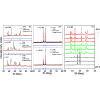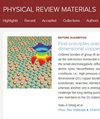Subjugating extensive magnetostructural temperature window and giant magnetocaloric effect in B-doped (MnNiSi)0.67(Fe2Ge)0.33 hexagonal system
IF 3.4
3区 材料科学
Q2 MATERIALS SCIENCE, MULTIDISCIPLINARY
引用次数: 0
Abstract
Coupled first-order magnetostructural transformations (FOMSTs) with narrow widths governed by low external stimuli play a crucial role in magnetic refrigeration for ferromagnetic hexagonal systems. In this work, we report a family of magnetocaloric materials named boron (B)-doped compounds that are devoid of rare-earth elements. Our results show that varying B concentrations up to 5 at. % can tailor the robust FOMSTs between the low-temperature ferromagnetic orthorhombic phase and the high-temperature paramagnetic hexagonal phase in a wider temperature regime. A dramatic change in hysteresis () from ∼25 K for to ∼8 (9) K as well as increases in the saturation magnetization for specific 2 (3) at. % of B dopants is pronounced. Henceforth, the origin of the reducing hysteresis is illustrated based on the geometrical compatibility conditions between the austenite and martensite phases using temperature-dependent powder x-ray diffraction analysis. Moreover, we found the samples performed with good functional stability from the thermal cycling run. The branch of these B doping materials exhibits robust features of a large magnetocaloric effect (MCE) over an extensive temperature range (∼71 K) and temperature-averaged magnetic entropy change at a lower magnetic field change of 2 T. These several tangible benefits, such as reduced , geometrical compatibility, and robust MCE properties are first reported in the studied hexagonal system. Therefore, our results offer a viable approach to improve the cascading of these materials towards the application of cooling technology.

掺 B (锰镍硅)0.67(铁2锗)0.33 六方体系中的广泛磁结构温度窗口与巨磁效应的共轭
在铁磁性六方体系的磁制冷过程中,由低外部刺激控制的窄宽度耦合一阶磁结构转变(FOMST)起着至关重要的作用。在这项研究中,我们报告了一系列不含稀土元素的磁致冷材料,它们被命名为掺硼(B)的 (MnNiSi)0.67(Fe2Ge)0.33 化合物。我们的研究结果表明,改变硼的浓度(最高可达 5 at.当 x=0 时,磁滞(ΔThys)从 ∼25 K 急剧下降到 ∼8 (9) K,同时饱和磁化率在特定的 2 (3) at.B掺杂剂的百分比明显增加。因此,我们利用随温度变化的粉末 X 射线衍射分析,根据奥氏体和马氏体相之间的几何相容性条件 (λ2∼1) 来说明还原磁滞的起源。此外,我们还发现样品在热循环运行中具有良好的功能稳定性。这些掺 B 材料的分支在很大的温度范围(∼ 71 K)内表现出强大的磁致效应(MCE),并在较低的磁场变化 2 T 时表现出温度平均磁熵变化。因此,我们的研究结果为改进这些材料的级联以应用冷却技术提供了一种可行的方法。
本文章由计算机程序翻译,如有差异,请以英文原文为准。
求助全文
约1分钟内获得全文
求助全文
来源期刊

Physical Review Materials
Physics and Astronomy-Physics and Astronomy (miscellaneous)
CiteScore
5.80
自引率
5.90%
发文量
611
期刊介绍:
Physical Review Materials is a new broad-scope international journal for the multidisciplinary community engaged in research on materials. It is intended to fill a gap in the family of existing Physical Review journals that publish materials research. This field has grown rapidly in recent years and is increasingly being carried out in a way that transcends conventional subject boundaries. The journal was created to provide a common publication and reference source to the expanding community of physicists, materials scientists, chemists, engineers, and researchers in related disciplines that carry out high-quality original research in materials. It will share the same commitment to the high quality expected of all APS publications.
 求助内容:
求助内容: 应助结果提醒方式:
应助结果提醒方式:


